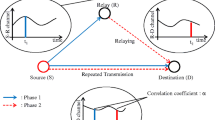Abstract
In multi-hop relay systems, due to considerably small allocation times in a perfectly orthogonal time division multiple access (TDMA) protocol or greatly large length of sequence in a perfectly orthogonal code division multiple access (CDMA) protocol, a channel capacity of multi-hop relay systems is deteriorated. In order to improve the channel capacity, a spatial reuse TDMA/CDMA protocol is proposed, a performance of both protocols is analyzed and compared in perfect and imperfect channel state information. The optimal number of phases in the spatial reuse TDMA protocol and the optimal length of sequence in the spatial reuse CDMA protocol that can achieve the maximal channel capacity will be discussed in this paper. The numerical evaluation result indicates the channel capacity of spatial reuse TDMA/CDMA is higher than that of systems have perfect orthogonality or without TDMA/CDMA.







Similar content being viewed by others
References
Rosas, F., & Oberli, C. (2013). Nakagami-m approximations for multiple-input multiple-output singular value decomposition transmissions. IET Communications, 7(6), 554–561.
Chang, D. C., & Guo, D. L. (2013). Spatial-division multiplexing MIMO detection based on a modified layered OSIC scheme. IEEE Transactions on Wireless Communications, 12(9), 4258–4271.
Wang, B., Zhang, J., & host-Madsen, A. (2005). On the capacity of MIMO relay channel. IEEE Transactions on Information Theory, 51(1), 29–43.
Gastpar, M., & Vetterli, M. (2005). On the capacity of large Gaussian relay networks. IEEE Transactions on Information Theory, 51(3), 765–779.
Zhang, J., Wang, Y., Ding, L., & Gao, J. (2013). On the error probability of spatial modulation over keyhole MIMO channels. IEEE Communications Letters, 17(12), 2221–2224.
Levin, G., & Loyka, S. (2010). On the outage capacity distribution of correlated keyhole MIMO channels. IEEE Transactions on Information Threory, 54(7), 3232–3245.
Giindiiz, D., Khojastepour, M. A., Goldsmith, A., & Vincent Poor, H. (2010). Multi-hop MIMO relay networks: Diversity-multipleplexing trade off analysis. IEEE Transactions on Wireless Communications, 9(5), 1738–1747.
Hiep, P. T., Kohno, R., & Fumie, O. (2012). Optimizing distance, transmit power and allocation time for reliable multi-hop relay system. EURASIP Journal on Wireless Communications and Networking, 2012, 1.
Hiep, P. T., Hoang, N. H., Sugimoto, C., & Kohno, R. (2013). End-to-end channel capacity of MAC-PHY cross-layer multiple-hop MIMO relay system with outdated CSI. EURASIP Journal on Wireless Communications and Networking, 2013, 1.
Diamant, R., & Lampe, L. (2011). Spatial reuse time-division multiple access for broadcast ad hoc underwater acoustic communication networks. IEEE Journal of Oceanic Engineering, 36(2), 172–185.
Anderson, E., Phillips, C., Sicker, D., & Grunwald, D. (2014). Optimization decomposition for scheduling and system configuration in wireless networks. IEEE/ACM Transactions on Networking, 22(1), 271–284.
Ergen, S. C., & Varaiya, P. (2009). TDMA scheduling algorithms for wireless sensor networks. Wireless Network. doi:10.1007/s11276-009-0183-0.
Divar, S., Karthik, K. S., Ramamurthi, B., & Koilpillai, R. D. (2013). Downlink throughput enhancement of a cellular network using two-hop user-deployable indoor relays. IEEE Journal on Selected Areas in Communications, 31(8), 1607–1617.
Ye, W., & Cui, H. (2007). Mining of reuse patterns in CDMA network optimization. In Eighth ACIS international conference on software engineering, artificial intelligence, networking, and parallel/distributed computing (Vol. 3)
Simon, M. K., Omura, J. K., Scholtz, R. A., & Levitt, B. L. (1994). Spread spectrum communication handbook. New York: McGraw-Hill, Inc.
Sawate, D. V., & Pursley, M. B. (1980). Crosscorrelation properties of pseudorandom and related sequences. Proceedings of the IEEE, 68(5), 593–619.
Author information
Authors and Affiliations
Corresponding author
Rights and permissions
About this article
Cite this article
Van Son, V., Hiep, P.T. & Kohno, R. Spatial Reuse TDMA/CDMA in Multi-hop MIMO Relay Systems with Imperfect CSI. Wireless Pers Commun 84, 1197–1208 (2015). https://doi.org/10.1007/s11277-015-2683-9
Published:
Issue Date:
DOI: https://doi.org/10.1007/s11277-015-2683-9




